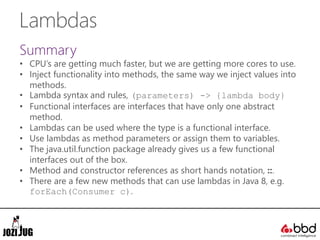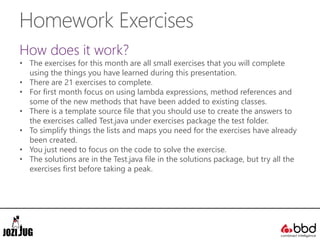Ad
Streams in Java 8
- 1. Streams in Java 8 Start programming in a more functional style
- 2. Background Who am I? • Tobias Coetzee • I’m a Technical Lead at BBD • I present the Java Expert Level Certifications at BBD (EJB, JPA, etc.) • I’m currently a banker • Part of the JoziJug organising committee • I like to run • This partially presentation is based on a Simon Ritter course • @tobiascode • https://github.com/Jozi-JUG/streamtraining
- 3. Outcomes What are the take away’s? • Know the differences between functional and imperative programming • Be able to define the elements of a stream • Use intermediate and terminal operations • Create streams from different data types • Avoid NullPointerExceptions with the Optional Class • Debug streams
- 4. What Did We Do Last Time?
- 5. Lambdas Summary • CPU’s are getting much faster, but we are getting more cores to use. • Inject functionality into methods, the same way we inject values into methods. • Lambda syntax and rules, (parameters) -> {lambda body} • Functional interfaces are interfaces that have only one abstract method. • Lambdas can be used where the type is a functional interface. • Use lambdas as method parameters or assign them to variables. • The java.util.function package already gives us a few functional interfaces out of the box. • Method and constructor references as short hands notation, ::. • There are a few new methods that can use lambdas in Java 8, e.g. forEach(Consumer c).
- 7. Functional Programming Remember this game?
- 8. Functional Programming Imperative • Values associated with names can be changed, i.e. mutable state. • The order of execution is defined as a contract. • Repetition is external and explicit, we are responsible for the “how”. Functional (Declarative) • Values associated with names are set once and cannot be changed, i.e. immutable state. • Order of execution is not defined • Repetition is through the use of recursion or internal repetition, the “how” is hidden away. Thinking about a problem in terms of immutable values and functions that translate between them.
- 9. “Multithreaded programming, requiring synchronised access to shared, mutable state, is the assembly language of concurrency”
- 10. The Elements of a Stream
- 11. Elements of a Stream What are streams? • Streams give us functional blocks to better process collections of data with, monads. • We can chain these blocks together to process collections of data. • Streams aren’t another data structure. • Streams can process an infinite list of data. • Streams use internal iteration meaning we don’t have to code external iteration, the “how”. • Streams support functional programming as suppose to imperative programming.
- 12. “The purpose of streams isn’t just to convert from one collection to another; it’s to be able to provide a common set of operations over data”
- 13. Elements of a Stream Structure of a Stream • A stream consists of 3 types of things 1. A source 2. Zero or more intermediate operations 3. A terminal operation result = albums.stream() .filter(track -> track.getLength() > 300) .map(Track::getName) .collect(Collectors.toSet()); Source Intermediate Operation Intermediate Operation Terminal Operation Result
- 15. Elements of a Stream How they work • The pipeline is only evaluated when the terminal operation is called. • The terminal operations pulls the data, the source doesn’t push it. • Uses the stream characteristics to help identify optimisations. • This allows intermediate operations to be merged: • Avoiding multiple redundant passes on data • Short-circuit operations • Laze evaluation • The stream takes care of the “how”.
- 17. Intermediate Operations Intermediate • A stream provides a sequence of elements. • Supports either sequential or parallel aggregate operations. • Most operations take a parameter that describes its behaviour, the “what”. • Typically using lambda expressions. • Must be non-interfering • Stateless • Streams can switch between sequential and parallel, but all processing is either done sequential or parallel, last call wins.
- 18. Intermediate Operations Filtering and Mapping Interface Description filter(Predicate) Returns a stream with only those elements that return true for the Predicate map(Function) Return a stream where the given Function is applied to each element on the input stream mapToInt, mapToDouble, mapToLong Like map(), but producing streams of primitives rather than objects. distinct() Returns a stream with no duplicate elements
- 19. Intermediate Operations Map() and FlatMap() • Map values from a stream either as one-to-one or one- to-many, but still only produce one stream. map() input stream output stream one-to-one flatMap() input stream output stream one-to-many
- 20. Intermediate Operations Sizing and Sorting Interface Description skip(long) Returns a stream that skips the first n elements of the input stream limit(long) Return a stream that only contains the first n elements of the input stream sorted(Comparator) Returns a stream that is sorted with the order determined by the Comparator. With no arguments sorts by natural order. unordered() Returns a stream that is unordered (used internally). Can improve efficiency of operations like distinct() and groupingBy()
- 22. Terminal Operations Terminal • Terminates the pipeline of the operations on the stream. • Only at this point is any processing performed. • This allows for optimisation of the pipeline: • Lazy evaluation • Merged/fused operations • Elimination of redundant operations • Parallel execution • Generates an explicit result of a side effect.
- 23. Intermediate Operations Matching Elements and Iteration Interface Description findFirst(Predicate) The first element that matches predicate findAny(Predicate) Like findFirst(), but for a parallel stream allMatch(Predicate) All elements in the stream match predicate anyMatch(Predicate) Any element in the stream matches predicate noneMatch(Predicate) No elements match the predicate forEach(Consumer) Performs an action on each element forEachOrdered(Consumer) Like above, but ensures order is respected when used for parallel stream * * * Encourages non-functional programming style
- 24. Intermediate Operations Collecting Results and Numerical Results Interface Description collect(Collector) Performs a mutable reduction on a stream toArray() Returns an array containing the elements of the stream count() Returns how many elements are in the stream max(Comparator) The maximum value element of the stream, returns an Optional min(Comparator) The minimum value element of the stream, returns an Optional average() Return the arithmetic mean of the stream, returns an Optional sum() Returns the sum of the stream elements * There are a lot of built-in Collectors *
- 25. Terminal Operations Creating a Single Result • The collect function isn’t the only option. • reduce(BinaryOperator accumulator) • Also called folding in FP. • Performs a reduction on the stream using the BinaryOperator. • The accumulator takes a partial result and the next element and returns a new partial result as an Optional. • Two other versions • One that takes an initial value. • One that takes an initial value and BiFunction.
- 27. Stream Sources
- 28. Stream Sources JDK 8 Libraries • There are 95 methods in 23 classes that return a stream, most are intermediate operations though. • Leaves 71 methods in 15 classes that can be used as practical sources. • There are numerous places to get stream sources. • Streams from values • Empty streams • Streams from functions • Streams from arrays • Streams from collections • Streams from files • Streams from other sources
- 29. Stream Sources Collection Interface • stream() • Provides a sequential stream of elements in the collection. • parallelStream() • Provides a parallel stream of elements in the collection. • Uses the fork-join framework for implementation. • Only Collection can provide a parallel stream directly. Arrays Class • stream() • Array is a collection of data, so logical to be able to create a stream. • Provides a sequential stream. • Overloaded methods for different types, int, double, long, Object
- 30. Stream Sources Some other Classes • Files Class: find, list, lines, walk. • Random numbers to produce finite or infinite streams with or without seeds: Random, ThreadLocalRandom, SplittableRandom. • BufferReader, JarFile, ZipFile, Pattern, Charsequence, etc.
- 31. Stream Sources Primitive Streams • IntStream, DoubleStream, LongStream are primitive specialisations of the Stream interface. • range(int, int), rangeClosed(int, int) • A stream from a start to an end value (exclusive or inclusive) • generate(IntSupplier), iterate(int, IntUnaryOperator) • An infinite stream created by a given Supplier. • iterate uses a seed to start the stream.
- 32. Optional
- 33. Optional Problems with null • Certain situations in Java return a result which is a null, i.e. the reference to an object isn’t set. • It tries to help eliminate NullPointerException’s. • Terminal operations like min(), max(), may not return a direct result, suppose the input stream is empty? • Introducing Optional<T>: • It is a container for an object reference (null, or real object). • It is a stream with either 0 or 1 elements, but never null. • Can be used in powerful ways to provide complex conditional handling. • Doesn’t stop developers from returning null, but an Optional tells you do maybe rather check. • Was added for the Stream API, but you can also use it.
- 34. Optional Creating an Optional • <T> Optional<T> empty(): Returns an empty Optional. • <T> Optional<T> of(T value): Returns an Optional containing the specified value. If the specified value is null, it throws a NullPointerException. • <T> Optional<T> ofNullable(T value): Same as above, but if the specified value is null, it returns and empty Optional.
- 35. Optional Getting Data from an Optional • <T> get(): Returns the value, but will throw NoSuchElementException is value is empty. • <T> orElse(T defaultValue): Returns the default value if value is empty. • <T> orElseGet(Supplier<? Extends T> defaultSupplier): Same as above, but supplier gets the value. • <X extends Throwable> T orElseThrow(Supplier<? Extends T> exceptionSupplier): If empty throw the exception from the supplier.
- 39. Debugging Streams Solution • Most IDE’s will support debugging Streams and breakpoints on streams. • As you can pass in the behaviour for each operation via a lambda you can always add a System.out.println() or logging as part of the behaviour. • If you don’t want to mess around with your current behaviour you can use the peek operation. • The peek(Consumer <? Super T> action) methods was added for debugging and should only be used for debugging. • Each element will pass through it and the action will be applied to it.
- 40. Homework
- 41. Homework Exercises How does it work? • The exercises for this month are all small exercises that you will complete using the things you have learned during this presentation. • There are 21 exercises to complete. • For first month focus on using lambda expressions, method references and some of the new methods that have been added to existing classes. • There is a template source file that you should use to create the answers to the exercises called Test.java under exercises package the test folder. • To simplify things the lists and maps you need for the exercises have already been created. • You just need to focus on the code to solve the exercise. • The solutions are in the Test.java file in the solutions package, but try all the exercises first before taking a peak.
- 42. Books
- 43. Books on Lambdas and Streams
- 44. Thank you!


































































































































